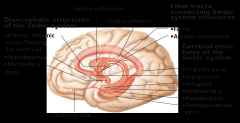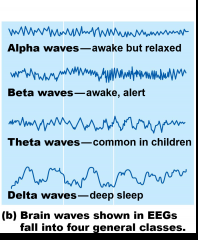![]()
![]()
![]()
Use LEFT and RIGHT arrow keys to navigate between flashcards;
Use UP and DOWN arrow keys to flip the card;
H to show hint;
A reads text to speech;
19 Cards in this Set
- Front
- Back
|
What is a functional brain system? (definition) |
Networks of neurons that work together but span large distances and as such are difficult to localize |
|
|
What are the different functional brain systems? |
1) The Limbic system (emotional or affective brain) - encircles the upper part of the brain stem (limbis =ring) and includes medial portions of the cerebral hemispheres and diencephalon
2) The Reticular Formation - made up of neuron clusters extending through the central core of the medulla, pons and midbrain |
|
|
Diagram of the brain sections for the Limbic system |

|
|
|
What are the main Cerebral structures of the Limbic system? |
1) Cingulate gyrus a) Expressing emotion through gestures, resolving mental conflicts when frustrated 2) Hippocampus a) Storage and retrieval of long term memory b) Most output relayed through here 3) Amygdala a) An almond-shaped nucleus that sits on the tail of the caudate nucleus b) Recognizes angry or fearful facial expressions, assesses danger, and elicits the fear response |
|
|
What are the main Diencephalon structures of the Limbic system? |
1) Hypothalamus a) Limbic system output runs through here b) Clearing house for visceral and emotional responses - Responsible for psychosomatic (emotion induced) illness 2) Anterior thalamic nuclei - Sensory relay station 3) Mammillary body - olfactory relay stations |
|
|
What fiber tract connects the limbic system structures of the diencephalon? |
- the Fornix |
|
|
What is the Reticular formation? |
1) Fiber tracts and nuclei in the midbrain, pons, and medulla 2) Connect widespread neurons in the brain 3) Reticular activating system (RAS) |
|
|
How does the Reticular activating system (RAS) work? |
- All ascending sensory tracts synapse here to keep us conscious and awake - Filters out unnecessary stimuli (99% of all stimuli) (LSD interferes with these sensory dampers, causes sensory overload) |
|
|
How is the Reticular activating system inhibited? |
Inhibited by: 1) Sleep centers in the hypothalamus 2) Depressed by alcohol 3) Sleeping pills, tranquilizers - severe damage can lead to a coma |
|
|
What are the reticular autonomic centers and what do they do? |
1) Vasomotor centers 2) Cardiac center 3) Respiratory centers Function - regulate visceral motor functions |
|
|
What does motor function of reticular formation do? |
- helps control coarse limb movements via reticulospinal tracts |
|
|
Stuff about higher mental functions |
Analysis of higher mental functions include:
1) Language 2) Memory 3) Brain waves and EEGs 4) Consciousness 5) Sleep and sleep-wake cycles |
|
|
Stuff about language |
Language implementation system involves associated cortex of left hemisphere Main areas include: 1) Broca's area - involved in speech production - patients with lesion in Broca's understand words, but cannot speak 2) Wernicke's area - involved in understanding spoken and written words - patients w/ lesions in Wernicke's can speak, but words are non-sensible |
|
|
What is memory? |
The storage and retrieval of information |
|
|
What are the different types of memory? |
1) Declarative - memory of facts (names, faces, words, dates) 2) Procedural - memory of skill (playing piano) 3) Motor - memory of motor skills (riding a bike) 4) Emotional - memory of experiences linked to an emotion (heart pounding when you hear a rattlesnake) |
|
|
What are the 2 stages of declarative memory storage? |
1) Short-term memory (STM, or working memory): temporary holding of info - limited to 7 or 8 pieces of info 2) Long-term memory (LTM) has limitless capacity |
|
|
What is homeostatic imbalance concerning memory functions? |
- Damage to hippocampus or surrounding temporal lobe structures on either side results in only slight memory loss - Bilateral destruction causes widespread amnesia - Anterograde Amnesia: consolidated memories are not lost, but new inputs are not associated with old one |
|
|
What is an EEG? What are its uses? |
Electroencephalogram - records electrical activity that accompanies brain function
1) Used for diagnosing epilepsy and sleep disorders 2) Localizes lesions, tumors, infarcts, infections, abscesses 3) Used in research and to determine brain death 4) Electrodes placed on scalp measure electrical potential differences between various cortical areas |
|
|
Picture showing an EEG readout of the different brain wave types |

|

